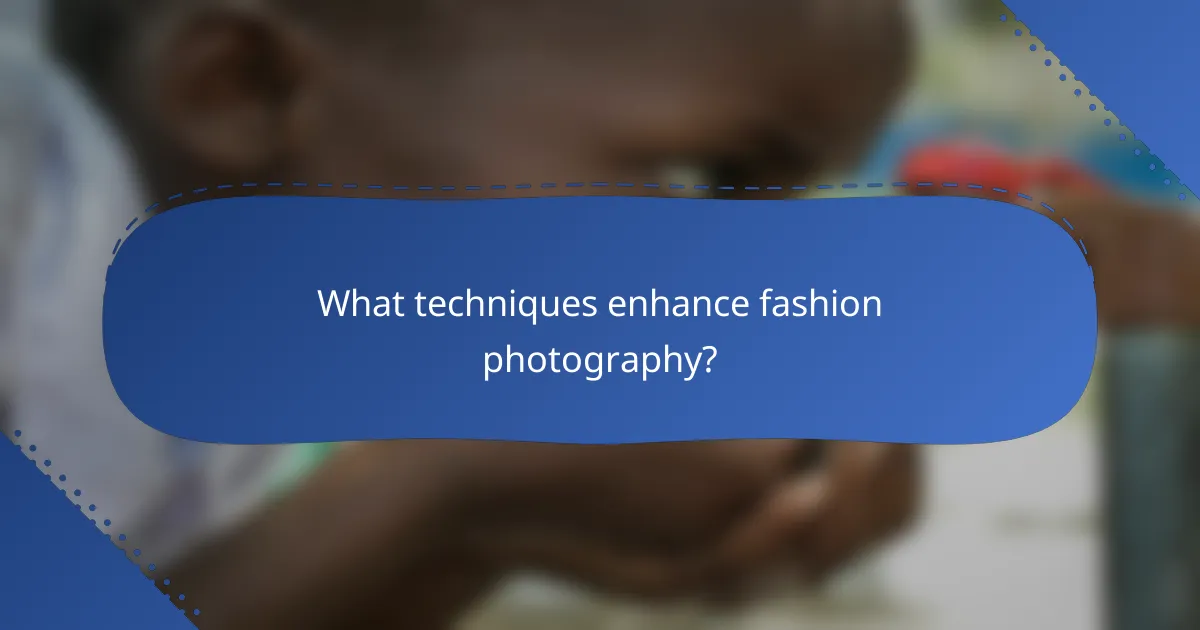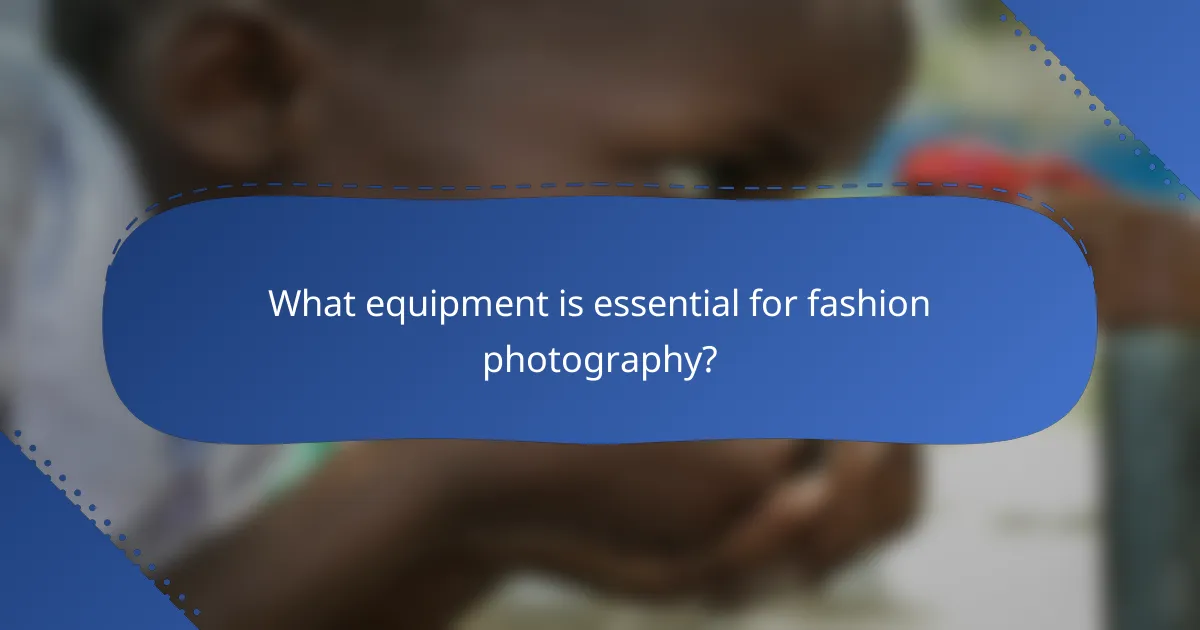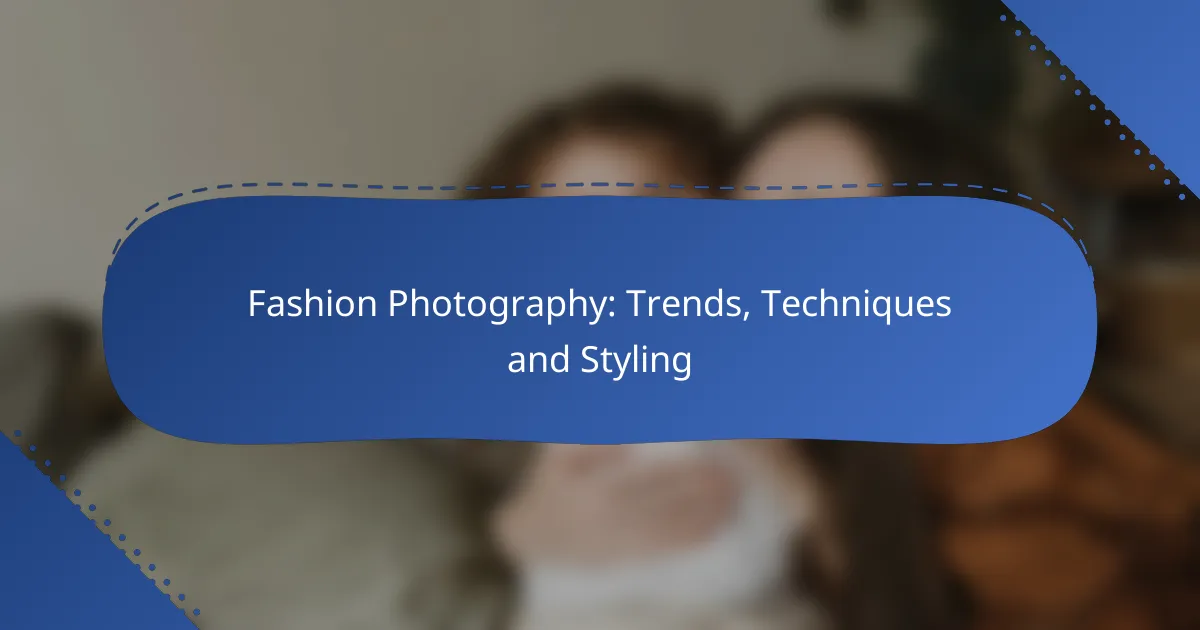Fashion photography is evolving, with a strong focus on creativity and authenticity that resonates with today’s audiences. By incorporating innovative techniques and thoughtful styling, photographers are able to capture striking images that reflect contemporary cultural and environmental themes while telling compelling stories through their work.

What are the latest trends in fashion photography?
The latest trends in fashion photography emphasize creativity, authenticity, and a connection to contemporary issues. Photographers are increasingly adopting innovative techniques and styles that resonate with modern audiences while reflecting current cultural and environmental themes.
Minimalist aesthetics
Minimalist aesthetics in fashion photography focus on simplicity and clean lines, often using a limited color palette and uncluttered backgrounds. This approach allows the clothing and models to stand out, emphasizing the design and details of the garments.
To achieve a minimalist look, consider using negative space effectively and choosing locations that are not visually overwhelming. This style often works well in studio settings or against plain backdrops, allowing for a strong focus on the subject.
Bold color palettes
Bold color palettes are gaining popularity in fashion photography, as vibrant hues can evoke strong emotions and create striking visuals. Photographers are experimenting with contrasting colors and unexpected combinations to make their images pop.
When incorporating bold colors, be mindful of how they interact with the clothing and the overall theme of the shoot. Using complementary colors can enhance the visual impact, while clashing colors may create a more avant-garde feel.
Use of natural light
The use of natural light has become a preferred technique for many fashion photographers, as it creates a soft, organic look that artificial lighting often cannot replicate. Shooting during golden hour, when the sunlight is warm and diffused, can enhance the mood of the images.
To make the most of natural light, scout locations that offer good lighting conditions and consider the time of day for your shoot. Avoid harsh midday sun, which can create unflattering shadows, and instead opt for early morning or late afternoon light.
Incorporation of technology
Incorporating technology into fashion photography is transforming the industry, with tools like drones, 360-degree cameras, and augmented reality enhancing creative possibilities. These technologies allow photographers to capture unique perspectives and create immersive experiences.
When using technology, ensure it complements your artistic vision rather than distracts from it. For instance, drones can provide stunning aerial shots, but they require careful planning and consideration of local regulations regarding drone usage.
Focus on sustainability
As sustainability becomes a central theme in fashion, photographers are increasingly highlighting eco-friendly practices and ethical fashion choices in their work. This trend involves showcasing sustainable materials and promoting brands that prioritize environmental responsibility.
To align with this focus, consider collaborating with eco-conscious brands and using natural settings that reflect a commitment to sustainability. Highlighting the story behind the clothing can resonate with audiences who value ethical consumption.

What techniques enhance fashion photography?
Techniques that enhance fashion photography include high-speed sync flash, creative composition, post-processing methods, and the effective use of props and backgrounds. Each technique contributes to capturing striking images that highlight fashion elements while maintaining visual appeal.
High-speed sync flash
High-speed sync flash allows photographers to use flash at shutter speeds faster than the camera’s normal sync speed, which is typically around 1/200 to 1/250 seconds. This technique is crucial for freezing motion and achieving well-lit images in bright conditions, making it ideal for outdoor shoots.
To effectively use high-speed sync, ensure your flash is compatible with your camera system. Adjust the flash power and exposure settings to balance ambient light and achieve the desired effect. Be mindful of battery life, as high-speed sync can drain batteries more quickly.
Creative composition
Creative composition involves arranging elements within the frame to create visually compelling images. Techniques such as the rule of thirds, leading lines, and framing can significantly enhance the storytelling aspect of fashion photography.
Experiment with different angles and perspectives to find the most flattering view of the model and the clothing. Incorporating negative space can also draw attention to the fashion pieces, allowing them to stand out in the image.
Post-processing methods
Post-processing methods are essential for refining fashion photographs and achieving a polished look. Common techniques include color correction, retouching, and applying filters to enhance mood and style.
Utilize software like Adobe Lightroom or Photoshop to adjust exposure, contrast, and saturation. Be cautious not to over-edit, as excessive retouching can lead to unnatural results. Aim for a balance that maintains the integrity of the clothing while enhancing the overall aesthetic.
Use of props and backgrounds
The use of props and backgrounds can elevate fashion photography by adding context and depth to the images. Selecting complementary props, such as accessories or furniture, can enhance the theme of the shoot and create a cohesive look.
When choosing backgrounds, consider colors and textures that will not distract from the fashion being showcased. Simple, clean backgrounds often work best, but don’t hesitate to experiment with bold patterns or colors that align with the fashion style. Always ensure that the props and backgrounds support the narrative you want to convey in the photographs.

How to style models for fashion shoots?
Styling models for fashion shoots involves selecting outfits, accessories, and beauty looks that align with the shoot’s theme and enhance the model’s features. Effective styling can significantly impact the overall aesthetic and storytelling of the photographs.
Choosing the right wardrobe
Selecting the appropriate wardrobe is crucial for conveying the desired mood and style. Consider the shoot’s theme, location, and target audience when choosing outfits. Fabrics should complement the model’s body type and skin tone, while colors should align with the overall palette of the shoot.
Incorporate a mix of textures and patterns to create visual interest. For example, pairing a sleek satin top with a textured skirt can add depth to the look. Always have a few backup options available to adapt to changing conditions or creative directions during the shoot.
Accessorizing effectively
Accessories can elevate a model’s outfit, adding personality and flair. Choose items that enhance the wardrobe without overwhelming it; for instance, a statement necklace can draw attention to the face, while oversized sunglasses can add a touch of glamour.
When selecting accessories, consider the scale and proportion in relation to the model and the outfit. A good rule of thumb is to keep accessories balanced; if the outfit is bold, opt for simpler accessories, and vice versa. Always ensure that accessories are in good condition and appropriate for the shoot’s theme.
Hair and makeup coordination
Hair and makeup should harmonize with the chosen wardrobe and overall concept of the shoot. Collaborate with a skilled stylist to create looks that enhance the model’s features while fitting the desired aesthetic. For example, soft waves can complement a romantic outfit, while a sleek ponytail may suit a more modern look.
Consider the lighting and setting of the shoot when planning hair and makeup. Bright, natural light may require more matte finishes to avoid shine, while studio lighting can allow for bolder colors. Always conduct a test run to ensure the final look translates well on camera.

What equipment is essential for fashion photography?
Essential equipment for fashion photography includes a reliable camera, suitable lenses, and effective lighting gear. These tools significantly influence the quality of images and the overall aesthetic of fashion shoots.
Camera selection
Choosing the right camera is crucial for capturing high-quality fashion images. A full-frame DSLR or mirrorless camera is often preferred for its superior image quality and performance in low light conditions. Look for models with fast autofocus and high burst rates to keep up with dynamic fashion shoots.
Consider brands like Canon, Nikon, or Sony, which offer a range of options suitable for various budgets. Ensure the camera has a good selection of compatible lenses to enhance versatility.
Lens recommendations
The choice of lens can dramatically affect the look of your fashion photography. A versatile zoom lens, such as a 24-70mm f/2.8, is ideal for capturing both full-body and close-up shots. For portraits, a prime lens like a 50mm or 85mm with a wide aperture can create beautiful bokeh and isolate the subject.
Additionally, using a wide-angle lens can help in tight spaces or when you want to capture more of the environment. Always consider the focal length and aperture to achieve the desired depth of field and perspective.
Lighting gear
Effective lighting is essential in fashion photography to highlight textures and colors. Natural light can be beautiful, but having a set of external lights, such as softboxes or speedlights, allows for greater control over the scene. Consider using continuous lights for video shoots or strobe lights for still photography.
When working indoors or in low-light situations, portable LED panels can provide consistent illumination. Always keep in mind the color temperature of your lights to maintain a cohesive look across your images.
